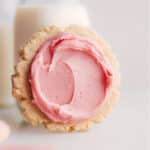Swig Sugar Cookies
These homemade Swig Sugar Cookies are soft, chewy, and thick, thanks to a blend of baking soda and cream of tartar. Topped with a rich layer of frosting, they’re the perfect sweet treat!
Servings: 22 large cookies
Cost: $7.43
Equipment
- Large sheet pan (15" x 21")
- Stand mixer with paddle attachment, or large bowl and hand mixer
- Food scale optional, but highly recommended, see note 1
- Silicone baking mat or parchment paper
Ingredients
- 8 tablespoons unsalted butter at room temperature
- 1-1/4 cup granulated sugar divided
- 1/2 cup powdered sugar
- 1 large egg
- 1-1/2 teaspoons vanilla extract
- 1/4 teaspoon almond extract or coconut extract, optional
- 1/3 cup vegetable oil or canola oil
- 3/4 teaspoon salt
- 1/2 teaspoon cream of tartar
- 1/2 teaspoon baking soda
- 3 cups all-purpose flour
Frosting
- 16 tablespoons unsalted butter at room temperature
- 4-1/2 cups powdered sugar
- 2 teaspoons vanilla extract or 1 teaspoon vanilla bean paste
- 1/8 teaspoon salt
- 4 tablespoons heavy cream plus extra to use as needed
- Red food coloring optional, to make frosting pink
Instructions
- Preheat oven to 350°F. Line a large dark-colored sheet pan with parchment paper or a silicone liner. (If using a light-colored sheet pan, add 2–4 minutes to the baking time).
- Using a stand mixer fitted with a paddle attachment (or a large bowl and hand mixer), cream butter, 2/3 cup granulated sugar, and powdered sugar until smooth and creamy. Add egg, vanilla, almond extract (if using), and vegetable oil. Beat at medium speed, scraping sides as needed, until creamy and silky-smooth looking.
- Add baking soda, cream of tartar, salt, and flour on top. Beat on low until integrated, then increase speed and beat until a smooth dough is formed. Don’t overmix.
- Roll even-sized dough balls (2 tightly packed tablespoons or 40 grams each). Add remaining 1/2 cup granulated sugar to a small bowl. Roll balls in the sugar and generously space apart on lined sheet pan (I only bake 6 at a time). Dip the bottom of a glass into the sugar, then press into the cookie until the edges crack a bit. (If dough is warm or feels overly soft/gooey, pop the tray of cookie dough in freezer for 15 minutes before baking—insurance from spreading in case the kitchen is overly warm or butter is too soft!)
- Bake 8–10 minutes. The cookies won’t brown and should look almost undercooked, but if you use a metal spatula to gently lift a cookie, the bottom should be slightly golden and not look wet at all. Right out of the oven, you may need to gently press the cup into the tops of the cookies again if they puffed up too much. (Don’t press down too hard, though.) Let cookies stand on the sheet pan 5 minutes before carefully transferring to a cooling rack. Let cool completely before frosting—cookies are fragile! Repeat with remaining dough until all cookies are baked.
- Prepare frosting while cookies are cooling: Using a stand mixer with a paddle attachment, beat butter on medium speed until creamy, about 2 minutes. Add 4½ cups powdered sugar, vanilla, and salt. Mix on low speed. Gradually pour in 1 tablespoon cream at a time (start with 4 tablespoons), and mix on medium-high speed until ingredients are integrated. Scrape sides and bottom as needed. Once integrated, add food coloring (if using), and beat on medium-high speed 2 minutes until smooth and creamy. Taste and adjust as desired. (Add more cream if needed for consistency. If frosting is too soft, add more powdered sugar.) If frosting is soft, chill 10–15 minutes before frosting.
- Gently frost completely cooled cookies using a table knife or off-set spatula. The frosting layer should be nice and thick! You’ll likely have about 1 cup of extra frosting. You can use leftover frosting on pancakes/waffles, a small batch of cupcakes, etc.) Enjoy!
Video
Notes
Note 1: A food scale is an invaluable tool that can ensure precise measurements. If you have one, use it instead of measuring cups. Toggle over to the “Metric” measurement on the recipe card and use the grams listed, especially for measuring flour, ensuring consistent results in baking. Also use it to measure cookie dough balls to ensure evenly baked cookies!
Note 2: Using room-temperature butter is important for both cookies and frosting, as it will give both a smoother texture. Butter should not be melted or soft/greasy. If it’s too cold, dough won’t cream, and if it’s too warm, cookies will be greasy/spread.
Storage: Cover cookies tightly and store them at room temperature. They’re best eaten within 2–3 days. Freeze leftover cookie dough circles instead of baked cookies! See blog post section labeled “Storage” for more info.
Nutrition
Serving: 1serving | Calories: 371kcal | Carbohydrates: 52g | Protein: 2g | Fat: 18g | Saturated Fat: 10g | Polyunsaturated Fat: 3g | Monounsaturated Fat: 4g | Trans Fat: 1g | Cholesterol: 46mg | Sodium: 124mg | Potassium: 41mg | Fiber: 0.5g | Sugar: 38g | Vitamin A: 455IU | Vitamin C: 0.02mg | Calcium: 10mg | Iron: 1mg
